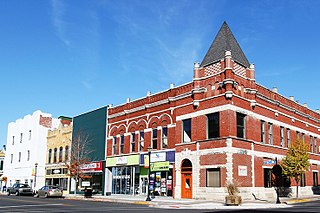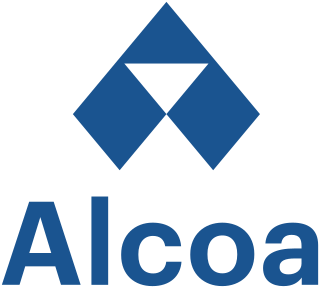Related Research Articles

Kokomo is a city in Indiana and the county seat of Howard County, Indiana, United States. It is the principal city of the Kokomo, Indiana Metropolitan Statistical Area, which includes all of Howard County, the Kokomo-Peru CSA, which includes Howard and Miami counties, as well as the North Central Indiana region consisting of six counties anchored by the city of Kokomo. Kokomo's population increased from 45,468 at the 2010 census to 59,604 in the 2020 census.
Smurfit-Stone Container Corporation was a global paperboard and paper-based packaging company based in Creve Coeur, Missouri, and Chicago, Illinois, with approximately 21,000 employees. In 2007, Smurfit-Stone was ranked 13 in PricewaterhouseCoopers' "Top 100" forest, paper, and packaging companies in the world as ranked by sales revenue. The company was also among the world's largest paper recyclers.

United States Steel Corporation, more commonly known as U.S. Steel, is an American integrated steel producer headquartered in Pittsburgh, Pennsylvania, with production operations in the United States and Central Europe. As of 2018, the company was the world's 38th-largest steel producer and the second-largest in the US, trailing only Nucor Corporation.

Alcoa Corporation is an American industrial corporation. It is the world's sixth largest producer of aluminum, with corporate headquarters in Pittsburgh, Pennsylvania. Alcoa conducts operations in 10 countries. Alcoa is a major producer of primary aluminum, fabricated aluminum, and alumina combined, through its active and growing participation in all major aspects of the industry: technology, mining, refining, smelting, fabricating, and recycling.

The Erie Lackawanna Railway, known as the Erie Lackawanna Railroad until 1968, was formed from the 1960 merger of the Erie Railroad and the Delaware, Lackawanna & Western Railroad. The official motto of the line was "The Friendly Service Route".
Nucor Corporation is a producer of steel and related products based in Charlotte, North Carolina. It is the largest steel producer in the United States, as well as the largest "mini-mill" steelmaker. It is also the biggest recycler of scrap in North America.

Allegheny Technologies Incorporated (ATI) is a specialty metals company headquartered at Six PPG Place in Pittsburgh, Pennsylvania.
Wheeling-Pittsburgh Steel was a steel manufacturer based in Wheeling, West Virginia.

Vornado Realty Trust is a real estate investment trust formed in Maryland, with its primary office in New York City. The company invests in office buildings and street retail in Manhattan.

AK Steel Holdings Corporation was a steelmaking company headquartered in West Chester Township, Butler County, Ohio. The company, whose name was derived from the initials of Armco, its predecessor company, and Kawasaki Steel Corporation, was acquired by Cleveland-Cliffs in 2020.

The Youngstown Iron Sheet and Tube Company, based in Youngstown, Ohio, was an American steel manufacturer. Officially, the company was created on November 23, 1900, when Articles of Incorporation of the Youngstown Iron Sheet and Tube Company were filed with the Ohio Secretary of State at Columbus. It acquired the Mark Manufacturing Company in 1923. Youngstown Sheet and Tube remained in business until 1977. A Youngstown resident acquired the name, trademark, and logo in 2014 and opened a small business promoting the economic redevelopment of Youngstown.
Morgan Park is a neighborhood in Duluth, Minnesota, United States.
Carpenter Technology Corporation develops, manufactures, and distributes stainless steels and corrosion-resistant alloys. In fiscal year 2018, the company's revenues were derived from the aerospace and defense industry (55%), the industrial and consumer industry (17%), the medical industry (8%), the transportation industry (7%), the energy industry (7%), and the distribution industry (6%). The company's products are used in landing gear, shaft collars, safety wires, electricity generation products, intervertebral disc arthroplasty, and engine valves and weldings.
Copperweld is an American company based in Fayetteville, Tennessee, and maintaining a management office in Brentwood, Tennessee. Its main products are wire and stranded electrical cable made from its Copperweld brand copper-clad steel ("CCS") or copper-clad aluminium ("CCA"). In addition to its American operations, Copperweld maintains a production facility in Telford, England, and a distribution hub in Liège, Belgium.
The Lackawanna Steel Company was an American steel manufacturing company that existed as an independent company from 1840 to 1922, and as a subsidiary of the Bethlehem Steel company from 1922 to 1983. Founded by the Scranton family, it was once the second-largest steel company in the world. Scranton, Pennsylvania developed around the company's original location. When the company moved to a suburb of Buffalo, New York, in 1902, it stimulated the founding of the city of Lackawanna.

Haynes International, Inc., headquartered in Kokomo, Indiana, is one of the largest producers of corrosion-resistant and high-temperature alloys. In addition to Kokomo, Haynes has manufacturing facilities in Arcadia, Louisiana, and Mountain Home, North Carolina. The Kokomo facility specializes in flat products, the Arcadia facility in tubular products, and the Mountain Home facility in wire products. In fiscal year 2018, the company's revenues were derived from the aerospace (52.1%), chemical processing (18.2%), industrial gas turbine (12.0%) and other (12.3%) industries. The company's alloys are primarily marketed under the Hastelloy and the Haynes brands. They are based on nickel, but also include cobalt, chromium, molybdenum, tungsten, iron, silicon, manganese, carbon, aluminum, and/or titanium.

Joy Global Inc. was a company that manufactured and serviced heavy equipment used in the extraction and haulage of coal and minerals in both underground and surface mining. The company had manufacturing facilities in Alabama, Pennsylvania, Texas, Wisconsin, Australia, Canada, China, France, South Africa and the United Kingdom. In 2017, Joy Global was acquired by Komatsu Limited and was renamed Komatsu Mining Corp.

The economy of Youngstown, Ohio, flourished in the 19th and early 20th centuries, with steel production reaching all-time highs at that time. The steel boom led to an influx of immigrants to the area looking for work, as well as construction of skyscrapers in the area. The city's population peaked at 170,002 in 1930, just at the onset of the Great Depression. World War II also brought a great demand for steel. After World War II, demand for steel dropped off dramatically, and industrial base of Youngstown began to see a decline.

The US iron and steel industry has paralleled the industry in other countries in technological developments. In the 1800s, the US switched from charcoal to coke in ore smelting, adopted the Bessemer process, and saw the rise of very large integrated steel mills. In the 20th century, the US industry successively adopted the open hearth furnace, then the basic oxygen steelmaking process. Since the American industry peaked in the 1940s and 1950s, the US industry has shifted to small mini-mills and specialty mills, using iron and steel scrap as feedstock, rather than iron ore.
References
- ↑ Continental Steel—Its Origin and History,rev. ed. (Kokomo, Indiana: Continental Steel Corporation, 1963), 3–13; "Continental Steel," Kokomo Tribune, February 23, 1996, D2.
- ↑ Continental Steel, 15–17; Kokomo Tribune, July 27, 1929, 9.
- ↑ Continental Steel, 17–20; New York Times, March 26, 1936, 37.
- ↑ Continental Steel, 20–21.
- ↑ Continental Steel,21-24-36.
- ↑ "Continental Steel," Kokomo Tribune, February 23, 1996, D2; New York Times, July 23, 1968, 47 and July 25, 1968, 47; Kokomo Tribune,January 7, 1969, 20.
- ↑ William T. Hogan, S.J., World Steel in the 1980s: A Case of Survival (Lexington, Massachusetts: Lexington Books, 1983), 113; William Scheuerman, The Steel Crisis: The Economics and Politics of a Declining Industry (New York: Praeger Publishers, 1986), 73–75.
- ↑ Hogan, 1–2, 97, 191–217.
- ↑ "Continental Steel," KokomoTribune, February 23, 1996, D4; "Penn-Dixie Industries may look like a slum, but to Jerry Castle, it's Fat City, U.S.A.," Forbes, June 15, 1976, 21–23; Joel Kotkin, "A Commitment Forged in Steel, Inc.,5 (June, 1983), 82–83; New York Times, May 27, 1977, 70 and August 30, 1979, D1; Dan Dornman, "An Invitation for Dining, Disco-Dancing...and the S.E.C." New York, May 9, 1977, 12–13.
- ↑ John P. Hoerr, And the wolf finally came: The Decline of the American Steel Industry (Pittsburgh: University of Pittsburgh Press, 1988), 65; New York Times, April 8, 1980, D5.
- ↑ Wall Street Journal, November 26, 1985, 1; "Continental Steel," Kokomo Tribune, February 23, 1996, D2-D3; Kokomo Tribune, October 12, 1986, 4.
- ↑ Kokomo Tribune, February 27, 1986, 1; "Continental Steel, Kokomo Tribune, February 23, 1996, D4.
- ↑ "Continental Steel," Kokomo Tribune, February 23, 1996, D3-D5; Kokomo Tribune, June 9, 2005, A1, A10; June 25, 2006, C1, C6; June 13, 2007, A10; New York Times, November 10, 2003, A12; Indiana Department of Environmental Management, "Second Five year Review Report for Continental Steel Superfund Site, City of Kokomo, Howard County, Indiana," ; Scott Smith, "Continental Steel Cleanup Moves to Quarry," Archived 2013-01-27 at archive.today June 8, 2008,
- ↑ "Kokomo solar park up and running". Kokomo Tribune. 12 January 2017. Retrieved 30 July 2017.
Books
Continental Steel—Its Origin and History. Rev. ed. Kokomo, Indiana: Continental Steel Corporation, 1963.
Hoerr, John P. And the wolf finally came: The Decline of the American Steel Industry. Pittsburgh: University of Pittsburgh Press, 1988.
Hogan, William T., S. J. World Steel in the 1980s: A Case of Survival. Lexington, Massachusetts: Lexington Books, 1983.
Scheuerman, William. The Steel Crisis: The Economics and Politics of a Declining Industry. New York: Praeger Publishers, 1986.
Articles
Dornman, Dan. "An Invitation for Dinging, Disco-Dancing...and the SEC," New York, May 9, 1977, 12–13.
Kotkin, Joel. "A Commitment Forged in Steel," Inc., 5 (June, 1983), 82–83.
"Penn-Dixie Industries may look like a slum, but to Jerry Castle, it's Fat City," Forbes, June 15, 1976, 21–23.
Newspapers
Kokomo Tribune, 1929–2009.
New York Times, 1929–2003.
Wall Street Journal, 1985.
Government report
Indiana Department of Environmental Management, "Second Five Year Review Report for Continental Steel Superfund Site, City of Kokomo, Howard County, Indiana," September, 2007.